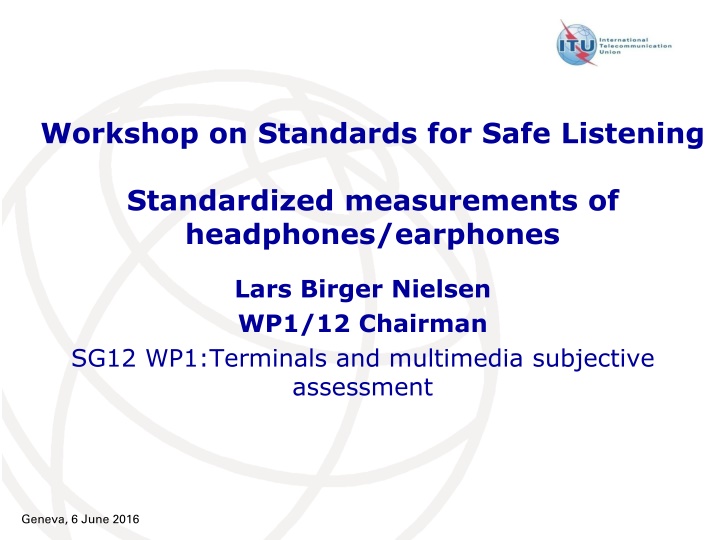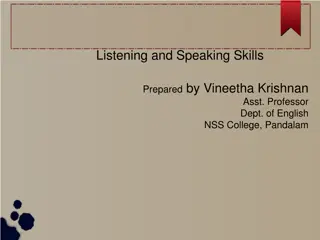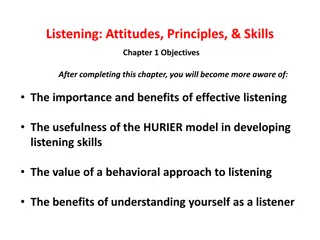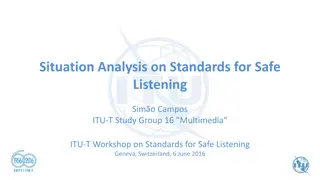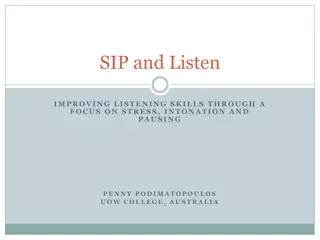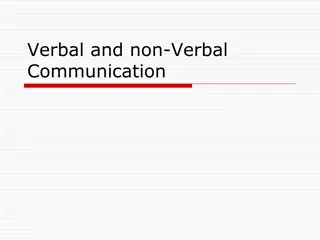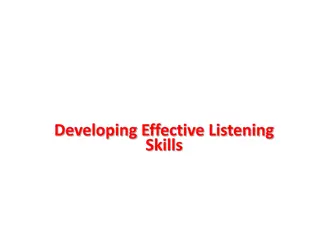Workshop on Standards for Safe Listening - Geneva 2016
This workshop focused on standardized measurements of headphones/earphones, covering objective and subjective methods, collaboration with other SDOs, and factors influencing sound pressure levels in headphones/earphones. Key topics included test procedures, setups, electroacoustic measurements, and recommendations for safe listening devices. The workshop emphasized reproducibility and accuracy in testing to ensure quality and safety standards.
Download Presentation

Please find below an Image/Link to download the presentation.
The content on the website is provided AS IS for your information and personal use only. It may not be sold, licensed, or shared on other websites without obtaining consent from the author.If you encounter any issues during the download, it is possible that the publisher has removed the file from their server.
You are allowed to download the files provided on this website for personal or commercial use, subject to the condition that they are used lawfully. All files are the property of their respective owners.
The content on the website is provided AS IS for your information and personal use only. It may not be sold, licensed, or shared on other websites without obtaining consent from the author.
E N D
Presentation Transcript
Workshop on Standards for Safe Listening Standardized measurements of headphones/earphones Lars Birger Nielsen WP1/12 Chairman SG12 WP1:Terminals and multimedia subjective assessment Geneva, 6 June 2016
Agenda Agenda Introduction to SG12 WP1 Measurements on headphones/earphones Summary Geneva, 6 June 2016 2
Introduction (1 of 2) SG12 WP1 responsibilities covers Objective methods Procedures for measurements of electroacoustic parameters of terminals (handset, hands-free, headsets, headphones and earphones) Physical setups for terminal when they are being tested Ensure reproducibility and a well defined accuracy when using standardized procedures and setups Subjective methods E.g. intelligibility just to mention one Geneva, 6 June 2016 3
Introduction (2 of 2) SG12 WP1 responsibilities covers Collaboration with other SDO (standards development organisations) e.g. ITU-T SG, ETSI STQ, IEEE, IEC Recommendations* dealing with test procedures and test setup of headset/headphones/earphones developed by experts: P.58 HATS (Head and Torso Simulator) P.311 Wideband Handset and Headset testing P.360 Acoustic shock for handset P.380 Electroacoustic measurements on headsets P.381 Headset interface testing *Standards for safe listening devices : situation analysis Geneva, 6 June 2016 4
Measurements on headphones/earphones (1 of 5) The following factors determines the sound pressure level produced in a headphone/earphone: Output voltage of the player Level of recorded music Sealing between ear and headphone/earphone Sensitivity of speaker in headphone/earphone Geneva, 6 June 2016 5
Measurements on headphones/earphones (2 of 5) For a specific headphone/earphone the variability in sound pressure level is caused by the mounting of the headphone/earphone (sealing) This is true even in the case of using standardized procedures and setups !!! In order to reduce the variation 5 measurements are performed and the average is used Geneva, 6 June 2016 6
Measurements on headphones/earphones (3 of 5) EN-50332-1 (intra-concha) +/- 1dB Measurement 1 Autospectrum right (Real) \ CPB Analyzer Measurement 2 Autospectrum right (Real) \ CPB Analyzer Measurement 3 Autospectrum right (Real) \ CPB Analyzer Measurement 4 Autospectrum right (Real) \ CPB Analyzer Measurement 5 Autospectrum right (Real) \ CPB Analyzer Cursor values X: 100.00 Hz Y: 64.44 dB(A)/20u Pa Y: 65.55 dB(A)/20u Pa Y: 63.47 dB(A)/20u Pa Y: 66.59 dB(A)/20u Pa Y: 67.06 dB(A)/20u Pa Total : 98.75 dB(A)/20u Pa Total : 99.56 dB(A)/20u Pa Total : 99.00 dB(A)/20u Pa Total : 99.66 dB(A)/20u Pa Total : 99.25 dB(A)/20u Pa [dB(A)/20u Pa] 90 80 70 60 50 40 30 20 10 31.5 63 125 250 500 1k 2k 4k 8k 16k [Hz] Geneva, 6 June 2016 7
Measurements on headphones/earphones (4 of 5) ITU-T Round Robin test 2003 (insert) +/-10dB 40.00 60.00 Headset 6 dBPa/V std. Dev. 30.00 50.00 20.00 40.00 10.00 30.00 0.00 20.00 -10.00 10.00 -20.00 0.00 100 1000 10000 frequency [Hz] Human Average dev1 dev2 3.3 Average 3.4 Average Geneva, 6 June 2016 8
Measurements on headphones/earphones (5 of 5) Newer studies show similar results as ITU-T Round Robin from 2003 Keith et al 2008 Playback levels ranged from 101 to 107 dBA at maximum volume level. Estimated listener sound levels could vary from 79 to 125 dBA due to the following factors. Evaluating the maximum playback sound levels from portable digital audio players Hammersh j et al 2015 shows that the dose estimate proposed by the EN 50332-3 is based on the output voltage of the music player alone, disregarding the sensitivity of the earphones used. The results presented show that this strategy will ignore differences of more than 10 dB. Geneva, 6 June 2016 9
Summary (1 of 2) The EN-50332-3 method Are based on measurement of the voltage produced by the player The influence of sealing and sensitivity are excluded in the determination of the actual sound pressure level presented to the user As a consequence the user can potentially be exposed to significantly higher levels before a warning is produced and as a consequence the risk of hearing damage is increased Alternatively a warning can be produced at too low levels and as a consequence the risk that the next warning being ignored is increased Geneva, 6 June 2016 10
Summary (2 of 2) Proposal for future standardisation activities To further develop the dose model to take into account the sealing and the sensitivity this could improved the accuracy of estimated sound pressure level the user are exposed to In addition an alternative method that are base on direct measurement of the reproduced sound pressure level e.g. using a microphone in the headphone/earphone could be developed Geneva, 6 June 2016 11
Other information More information available SG12 info http://www.itu.int/en/ITU-T/studygroups/2013-2016/12/Pages/default.aspx WP1 info http://www.itu.int/en/ITU-T/studygroups/2013-2016/12/Pages/structure.aspx Recommendations http://www.itu.int/ITU-T/recommendations/index_sg.aspx?sg=12 Thank you for your attention! Any Questions? Geneva, 6 June 2016 12
